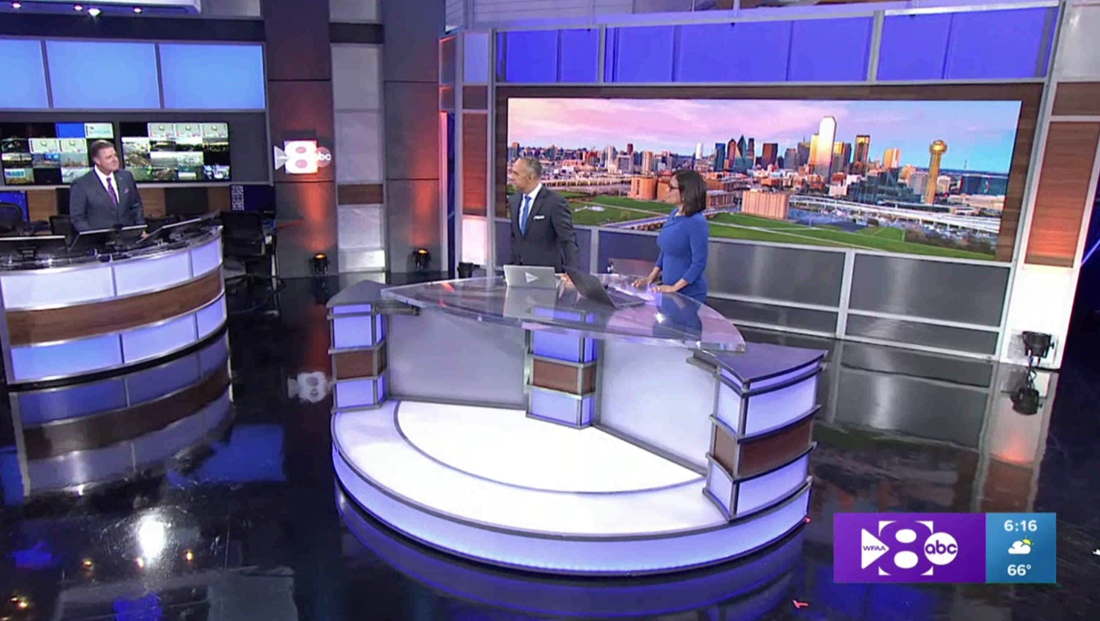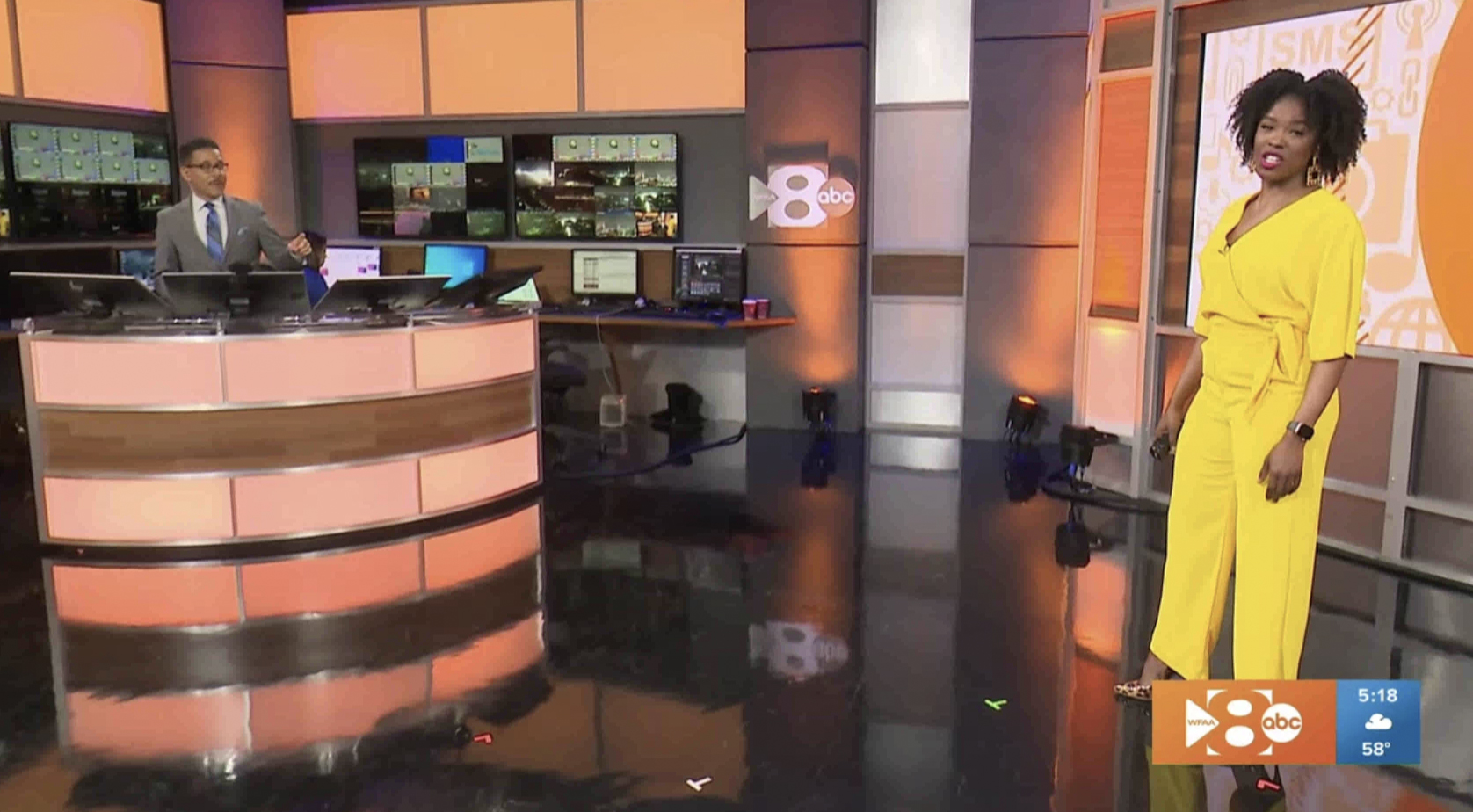Dallas station debuts its new two story studio

Subscribe to NewscastStudio for the latest news, project case studies and product announcements in broadcast technology, creative design and engineering delivered to your inbox.
After shuttering its windowed Victory Park Studio in late 2021, Tegna’s WFAA in Dallas has finally moved into its new digs, debuting a flexible, multivenue, two story set during its 6 p.m. newscast on Feb. 1, 2022.
The station had used space inside the mixed-use development adjacent to the American Airlines Center as its primary studio since 2007. The station opted to consolidate all operations to its Young Street facility which also had a studio that could be used instead of or in conjunction with the Victory Park location.
By mid-December 2021, the station was anchoring newscasts from a modified version of its newsroom standup location as it overhauled the main studio space. The approximately one month gap was needed because some LED display technology from Victory Park were brought over to Young Street and reused.
Following the station’s “arrow” logo and design element, it’s perhaps appropriate that the primary home base is situated in the corner of the studio, creating a multitiered wedge-shaped loft balcony above it.

For the 6 and 10 p.m. newscasts, the station’s “winged” Tegna style anchor desk from the old studio was brought over and placed in front of a wide video wall remiscient of the primary background at Victory Park, using it as a primary backdrop, though anchors and other talent frequently move around the space, including using a touchscreen standup area or “window” array on the other side of the space.

Standing behind this were co-anchors Chris Lawrence and Cynthia Izaguirre. This video wall can also be used for single anchor standups when shot off axis and two person standups without the desk.
A working staircase

Flowing down from the balcony is a functional staircase that allows talent to move from one level to another.
The steps terminate in a dramatic, angled landing a few risers above floor level that’s used primarily for standups and would be an ideal place to implement standups enhanced with augmented reality.
The modern, open staircase is left open underneath, giving viewers a glimpse at a shootoff wall with an arrow motif, metallic support columns and an X-shape tension wire element that adds a bit of an industrial feel while also serving as a nod to the arrow shape.
Tucked up in the higher levels of the loft are shorter flights of stairs that connect to an upper level of the station, allowing an alternate entry point.
This area also featured multiple large arrow accents on the walls and is equipped with a row of video panels and bar-style seating that went unused during the debut.
Floor to grid walls


While the balcony is the only space that talent can physically reach on the upper part of the set, the studio is essentially wrapped in scenery from floor to grid throughout the entire space.
Most of the upper walls, and much of the complete wall behind the stairs, are filled with an irregular array of rectangular panels set of by metallic frames. These panels are equipped with a mix of solid, edge lit and backlit elements with many of them featuring integrated color changing LED that allows them, like the space’s backlit headers and anchor desk segment to change color as needed.
The blocky collage of walls were featured on the Victory Park set, which was refreshed in 2018, and also draw on the metal framework that was featured in its original design. That look, in turn, was inspired by the modern metal and glass walls of the Victory Park development.
Faux windows
For 6 p.m. sports, the station used the “window” wall, a three segment wall with faux window frames backed with seamless LED, as a standup style area, showing a mix of topical and scenic graphics on them.


The window wall and other video panels throughout the studio were also used for “video on video” style shots with “floating camera” “walk and wander” bumps.
Forecaster Pete Delkus even moved over near this area to toss to the sports anchor after some brief crosstalk, before the camera pulled in tighter on just sports anchor Joe Trahan for his report.
At 10 p.m., sports was done from the balcony level with a smaller wall mounted LED panel serving as a sort of OTS graphic and the home base video wall showcasing a topical graphic in the wide jib shot at the top of the block. The balcony was also used for a weather tease at 6 p.m.


The “window” area was also used for a standing anchor position, with branded election graphics showing up on the panels behind the anchor before he tossed to a reporter on the balcony. The wide toss shot to the balcony showed the primary video wall with matching election graphics, as did the panel on the balcony array.
The studio also features multiple strong vertical lines, including wood and metallic fronted columns, some of which feature the station’s logo, that are dramatically uplit, a move that helps delineate the space visually.
A different look for mornings
For the station’s morning news, home base shifted to the window wall thanks to a wild anchor desk.
Most of the backlit surfaces were shifted to an orange shade, giving the space a brighter feel as compared to the darker, more dramatic look used in the evening.
The window wall, perhaps a nod to the old windowed studio, is topped by a large dark wall featuring an oversized version of the station logo, could showcase stylized cityscape photograph or realtime video feeds.


For most of the morning news, the wide nightside video wall was used for both traffic and “Speed Feed” segments, which are both presented by traffic anchor Tashara Parker. There’s also the opportunity for Parker to toss directly to weather, which is done from a working weather center with a curved presentation desk camera left of the primary evening anchor position.
Weather center


The weather center, also positioned in a corner, but without the diagonal video wall that the evening anchor area has, features a row of monitors showcasing various video feeds and also has workstations in addition to the presentation pod.
Given the severe weather expected in the region on debut day, both the evening and morning newscasts made heavy used of wide and toss shots between these two venues.
Both the weather center and window wall also boast floating internally lit header elements that help to visually “frame in” the segments shot here.
Other venues and camera shots


The debut morning show on Feb. 2, 2022, also used the touchscreen area to provide winter weather tips, with the anchors tossing to the position via a wide, rotating shot to where reporter Cleo Green was standing by. This shot is located adjacent to the studio’s chroma key wall and portions of it showed up frequently in the background.
That’s a common theme with how the new set is shot — letting viewers see the behind the scenes. The station relies heavily on locked down cameras that can only pan, tilt, zoom and boom robotically, so given the wide, sweeping shots of the space that are commonly used, it would be hard to avoid having the studio’s floor cameras or jib from appearing in at least some shots, so the station appears to have opted to embrace that and not necessarily worry about it showing up on air.
That said, many of those sweeping shots are achieved by either using a traditional jib with teleprompter or a handheld camera operator, though its usage is mixed in throughout the newscast.
It’s not uncommon for the station cut from a locked down shot of the anchor desk, for example, to a handheld shot that’s wider and shows of the cameras before the view shifts to another part of the space.
Project Credits
Set Design – Joe Lamberta Design
LED – Neoti
Subscribe to NewscastStudio for the latest news, project case studies and product announcements in broadcast technology, creative design and engineering delivered to your inbox.






tags
dallas, Inc., joe lamberta, Joe Lamberta Design, Mecca Productions, Neoti, wfaa
categories
Broadcast Design, Broadcast Industry News, Heroes, Set Design, TV News Set Design